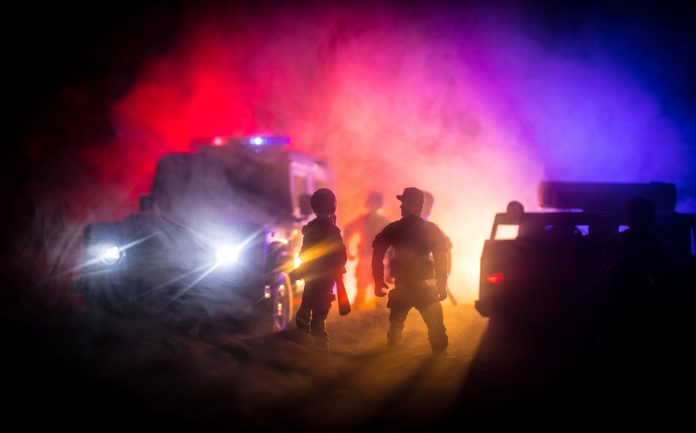In critical situations, the efficiency of emergency response can be the difference between life and death.
By KEVIN RUEF
In critical situations, the efficiency of emergency response can be the difference between life and death.
Staffing issues and outdated technology continue to inhibit 911 call centers from being as efficient as they can be, but artificial intelligence (AI) is changing that. Combined with video technology, AI can bridge the gap and help dispatchers make rapid decisions in high-stress situations.
Computer-aided dispatch (CAD) has been an important part of public safety systems for the past several decades. The first CAD programs came about in the 1960s, but it wasn’t until law enforcement adopted them in the 1990s that they saw widespread use.
CAD has gotten more complex over the years, leading to advances to recommend route changes, transfer vital data, optimize response teams and routes, and predict high-demand periods. Before the assistance of technology, this work fell on often stressed and understaffed human teams.
Emergency dispatchers have to disseminate information from a massive amount of people, leading to bottlenecks and delays. CAD systems take care of the volume and deliver pertinent information faster, allowing first responders to show up faster and better prepared.
Now, CAD capabilities are growing and evolving. With the addition of connected AI, machine learning, and video technology, dispatchers can be fully aware and prepared by not only accessing information about a scene quickly – but seeing the situation in real time.
Next Generation 911
Next Generation 911 (NG911) is a digital, internet protocol-based system that allows not only voice and text messages between the public and 911 dispatchers but photos and videos.
One of the biggest advantages of NG911 is that it can leverage the power of AI to improve call routing and communication with precise call locations and text messaging ability. This is not only important for situations when it would be dangerous to speak but makes the service more accessible to people with hearing challenges.
NG911 takes it a step further with video capability, however. High-reliability video-to-911 communication gives emergency responders the ability to connect to live video footage from the scene of a crime or accident instead of relying solely on the caller’s information. They can leverage their emergency response training to make more accurate assessments of the situation to inform first responders, ultimately improving the care the caller receives.
For example, Fairfax County, VA, had a legacy 911 system that struggled with handling multimedia communications like text, images, and videos from mobile callers, leading to challenges in relaying real-time information to first responders. The county implemented an NG911 system with IP-based infrastructure, which allowed seamless integration of text-to-911, video streaming, and real-time data sharing.
The result was improved location accuracy that reduced response times by 25% and improved situational awareness for first responders due to live video sharing.
Why Is NG911 Important?
Emergency services are a matter of life and death, but call centers have been overwhelmed with low staffing, outdated technology, and issues with stress and burnout. NG911 elevates call centers’ capabilities by supporting new communication formats like text and video for more accurate assessments and improved efficiency.
For example, during Hurricane Harvey, Houston’s traditional 911 system became overwhelmed, leading to call delays and difficulty in dispatching emergency services efficiently. The city transitioned to an NG911 system capable of handling large-scale emergency situations, with key features like cloud-based call routing, automatic caller location identification, and real-time coordination between emergency responders. The result was improved call processing speed by 40% and more efficient coordination with federal agencies.
Reliability is another concern with 911 call centers. Poor call service, which often occurs with legacy landlines, can cause calls to be disrupted or unclear. This ultimately affects how well the dispatcher can provide help. NG911 optimizes routing during disasters to ensure communication isn’t disrupted – even with a video feed.
In the case of crimes, the perpetrator is often gone before first responders can arrive. Having video access can buy valuable time to get more details about perpetrators that may lead to a future arrest.
Finally, NG911 can reduce the costs associated with 911 systems. Though often outdated, 911 systems require extensive maintenance that can be costly and time consuming. Like most technology solutions, NG911 reduces the maintenance, and the costs, involved in keeping these vital services running smoothly.
Other Applications
In addition to NG911, AI and video integration can be combined with other technologies to improve emergency response, such as:
Drones: Computer-aided drone dispatch has a notable application for large-scale emergencies. Drones are widely available, but with the addition of CAD and AI, drones can monitor long stretches of remote terrain or surveil wildfires or other natural disasters with a video feed. This is especially important for search and rescue in remote areas with limited infrastructure.
Voice Assistants: Voice assistants like Amazon Echo and Google Home are a staple in many homes. Users can ask for recipes, search for information, make calls, and more, all using their voice.
But with AI and video, voice assistants can be used to connect to a video feed in a situation when someone can’t do so themselves, ensuring the dispatchers has current information to make response decisions.
Wearable Technology: Wearable technology has incredible applications in healthcare, particularly for vulnerable populations. Tools like LifeAlert offer peace of mind for people who are at-risk but live alone, but AI and video technology can take it a step further with a video feed that can transmit automatically in a crisis. This gives first responders a view of the scene before they arrive, even if the person isn’t able to send a video themselves.
Smart Cities and Smart Buildings: Smart cities and smart buildings use digital technology to improve the management and efficiency of the environment. Some of the advancements include traffic route optimization, automated temperature control, and optimized lighting.
There are potential applications for AI with video in smart cities and buildings. In public areas with a video feed, AI-based video processing can identify critical scenarios like a cardiac arrest and activate emergency services. Early intervention is often crucial for improved survival rates, but there may not be a bystander nearby to help. AI with video alerts emergency services to deliver rapid care and improve outcomes. Automated emergency response is also helpful in the case of potential crimes for both the safety of the victim and gaining vital information to prosecute the criminal.
The Future of AI and Video Technology in EMS
The application of new technologies in EMS offers exciting possibilities, but there are still challenges to implementing these technologies in real-world scenarios. As more use cases emerge, it’s likely that AI and other technologies will become more widespread and efficient for use in emergency services to improve outcomes for the public and reduce some barriers for 911 call center staff and first responders.
About the Author:

Kevin Ruef co-founded 10-8 Systems after exceeding multiple companies’ sales records (both domestically and internationally). With more than a decade in sales, his experience ranges from B2B, B2G, and B2C. Since the company’s start in 2019, Kevin has been responsible for business development, strategic partnerships, and business operations.




